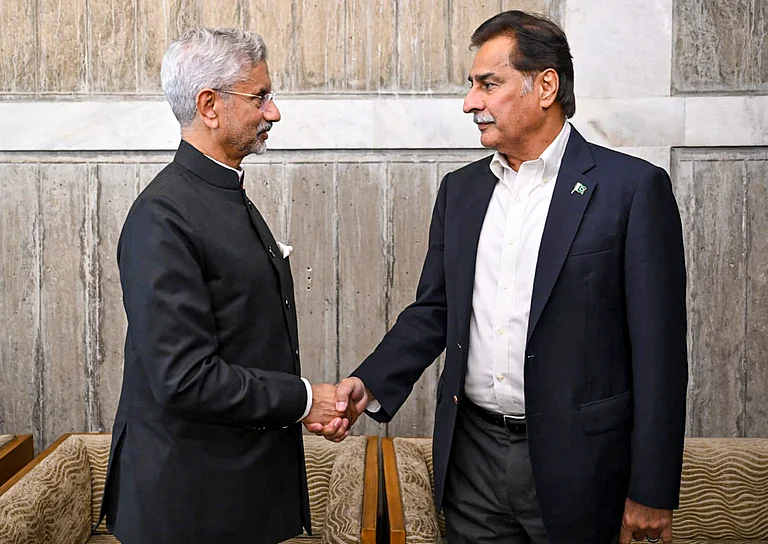Smiling only somewhat indulgently, Rekha Kumar (not her real name) tries to explain her husband’s ‘discount addiction’. “He needs it, you know,” she says, referring to Professor Kumar, a retired academician-about-town, who suddenly wakes up in the middle of the night to check at an online shopping site whether his discounts are increasing. At the end of an exhilarating couple of nights, where Kumar checked every hour, the packages arrived: an air fryer, an espresso machine, an electric kettle, and a DVD machine. “Everyone is checking,” he says, “and it was fun getting even small discounts,” he says.
In India’s popular festive Diwali season, discounts are not an uncommon sight. But this year, Indian retail’s new kids—online retailers—have been bending over backwards to attract customers through deep discounts, of a kind never heard of before. Earlier, discounts of 5-10 per cent were the norm in physical stores. Now, even for high-value products, the online discounts—on sites like Flipkart, Amazon, Jabong, Snapdeal—are 10-15 per cent. And in some product categories, the discounts are 70-80 per cent.
Be it the thrill of snagging an HP laptop worth Rs 29,000 for just Rs 18,000 or a Samsung Galaxy Note phone worth Rs 43,000 for just Rs 25,999, marketers are calling this online “shopping madness” a “tipping point” for the retail industry. Consumers, they feel, will be the winners here as the efficiencies promised by online shopping will challenge the thick profit margins being made by wholesalers, dealers, distributors and physical retailers (powerful lobbies all). As online shopping grows, experts feel the discount culture will only increase.
Are discounts then the only way to capture the price-sensitive Indian consumer? It is not that Indians want to pay less for products, but with a large population of internet-friendly youth with disposable incomes who are willing to spend and get the best value, discounting never fails. This applies especially to electronics, devices and fashion products. Sure, India is not a pioneer in discounted sales. In the US, deep discounting and the coupon system have been in practice for decades and even today families queue up to get even the smallest of discounts. This basic philosophy applies to India too.
But what is the need for online retailers to offer such unbelievable price cuts on products? For one, it is difficult for online players to fight with offline players where customers can “touch and feel” a product. Also, most Indians are yet to get convinced of the security and reliability of online retail, a point proved by the fact that even today, 80-85 per cent online sales happen on cash-on-delivery (CoD) basis. Even with that, about 20-25 per cent of the deliveries fail and are returned.
That leaves them with little option to get people on board. Says K. Vaitheeswaran, founder of India’s first e-commerce website, Indiaplaza, “The biggest benefit left for online players to offer is the price. So they are forced to offer big discounts to attract their customers.” The problem is that in this race, these discounts are being coined from their own money. As of now, though, online retailers, sitting on loads of cash from investors—Flipkart raised $1 billion a few months ago, Amazon announced $2 billion investment in India and eBay has invested in Snapdeal which is raising another $650 million—are subsidising this deep discount from their own pocket, or in other words, from investor money.
Harminder Sahni, founder, Wazir Advisors, a management consulting firm specialising in consumer and retail segments, feels that in India, companies have always enjoyed the lack of transparency in the supply chain management to charge unrealistic margins. That is what is being challenged by online players today who offer deep discounts, and the 40-50 per cent of the retail price that was going into the supply chain is now being eliminated. There is also the fact that in many cases, the online price is well below the dealer price a company offers and that is becoming a matter of concern for many.

Hallmark The Jabong warehouse in Pataudi, Haryana. (Photograph by Jitender Gupta)
Marketing experts say online retailers are following this new trend of “loss leader pricing” where they sell a small quantity of a product at a deep discount to attract customers and when that runs out, they expect customers to buy other products at less or no discount. Says Ankit Nagori, senior VP, marketplace, Flipkart, “Discounting during sales is not a new phenomenon and it helps sellers attract a larger customer base from time to time and grow their business.”
Many consumers also feel that a substantial portion of the products that online retailers sell includes phased-out or old product lines from companies. That might be true, considering that manufacturers always try to clear inventory of discontinued products, often on attractive terms. Says Singhal, “All manufacturers give extra margins on phased-out items because they want to clear stocks of old products.” This is different from practices followed by some global companies like Apple which officially drop prices of older products. The difference is that, in many cases, consumers find it difficult to get after-sales service or spares for discontinued products. And at a time when products are becoming obsolete every few months, this problem is only increasing.
Obviously, many manufacturers have not taken too well to this practice of deep discounting, often beyond their dealer or distributor price. They feel that such practices erode the brand value of products and kill sales in showrooms. Says the marketing head of an MNC, “They (online players) are spoiling the market and permanently altering consumer perception. This has badly impacted showroom sales as consumers are demanding online prices in our showrooms.”
Recently, many companies have also started putting out advisories asking customers to buy only from authorised offline resellers and even asking customers to check warranty conditions on online sales, vaguely indicating that normal warranty might not be available in some cases for online buyers. That may be one way of putting pressure, but legally, there is little they can do—a manufacturer has no right to refuse warranty regardless of where a consumer has bought a product from. If he does, it will be a clear case of unfair trade practice. Of course, in some cases where the products are not procured from India, companies may start questioning such issues.
Even the Competition Commission of India has said that as long as the consumer benefits, nothing needs to be done on the discounts. Says consumer affairs lawyer Jehangir Gai, “The law is very clear. A retailer cannot charge more than the Maximum Retail Price (MRP). But there is no law against charging anything below it even if it is subsidised from the retailer’s own pocket.” And online players—without overheads like rentals, shop staff salaries and inventory—are able to play better with the margins.
Actually, manufacturers too face a Hobson’s choice as they cannot let this discounts game—which is hurting their investment in offline stores—continue and they also cannot stop being present in the happening online stores. Says Vaitheeswaran, “The manufacturers are being politically correct and making political noises. They will continue to make noises and also continue supplying to these retailers as they cannot afford to stay away from online retailers.” Considering that manufacturers on an average invest anything between Rs 40 lakh and Rs 4 crore on an exclusive showroom, their concerns are understandable.
Even the BJP-led government is caught in a quandary. Despite having been vocal against organised retail, it has not been able to rein in online retail despite allegations of disguised FDI in many companies. Though the Enforcement Directorate has questioned the source of funds in Flipkart and the way of operations at Amazon, no decision has been forthcoming yet and that has been at the cost of hurting the bjp’s large constituency of traders and middlemen who have thrived in an offline retail scenario. In fact, despite publicly stating that it will reverse the UPA government’s decision on FDI in multi-brand retail, it is yet to act on its own promise.
Complicating matters is a new development—omni-mode retailers who have both an offline and online presence, much like what Walmart does in the US. Big Indian retailers like Reliance, Tata and Future group are working on online initiatives which could change the rules of the game, and with that, the advantage consumers have been enjoying. Future Group’s Kishore Biyani, for one, has made earlier attempts to start an online initiative but has not been successful yet. Recently, Biyani tied up with Amazon to sell his apparel brands, an arrangement that will be extended to other products soon. Mukesh Ambani-led Reliance Retail has also made public its intention to go online as has Tata’s Trent Retail. Once that happens, the squeeze will be tighter for the online players.
But for the consumers, the good times are here to stay either way. The discounts are expected to continue for a while. “Festival discounts and sales are here to stay. Of course, price is not the only way to push customer perceived value but it is a quick and sureshot way to do so in our country where desire is so strong, and good deals are irresistible,” says marketing and consumer expert Rama Bijapurkar. In that sense, India’s discount revolution is also (happily) irreversible.
***
Sale, Sale, Sale
For all the occasional scepticism—and valid doubts about specifics—this season is a win-win situation for the Indian consumer. Bewildering variety, a range of products and online retailers vying with each other for her attention.

***
Six Questions You, The Consumer, Must Ask
How deep can these discounts go?
There’s scope for further discounts, say online retailers; we could see up to 80 per cent discounts, depending on stocks, demand and nature of product.
Can government/manufacturers stop these online discounts?
The law says a retailer cannot charge above the MRP but nothing stops them from charging anything under the MRP. The Competition Commission has said as long as the move is pro-consumer, it is fine.
Do you get genuine products under such discount schemes?
Most products on discount are genuine and normally come with usual warranties. But be careful: there are also lots of local and Chinese products on offer.
How long will the discounting last?
As long as the online retailer can continue reducing margins or has money to burn, there will be no stopping such discounts.
How can the online players afford to give such big discounts?
Normally online retailers reduce their profit margins on a product. Beyond that, they feed discounts from the money they get from venture capital firms. All online players have deep pockets for now.
Is deep discounting unique to India?
No, it has come to India from the West. The US has a vibrant discounting culture and coupon system for all purchases.
***
The Tip Of The Salesberg
- $525 billion (2014) Size of total retail market in India
- $4 billion (2014) Size of online retail in India
- 243 million Total number of people using Internet in India
- 20 million Total number of people shopping online






















